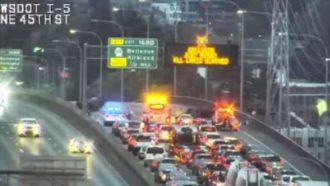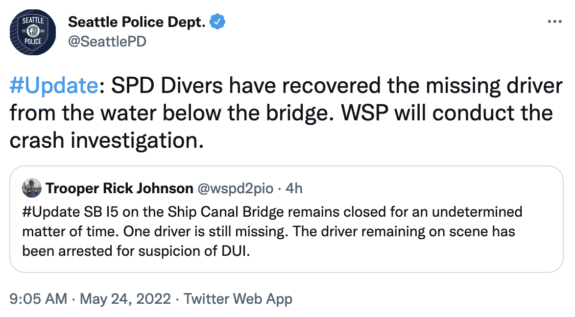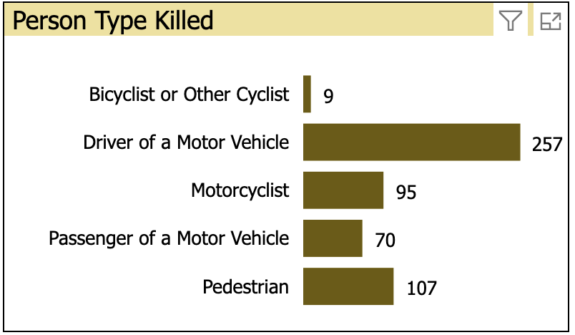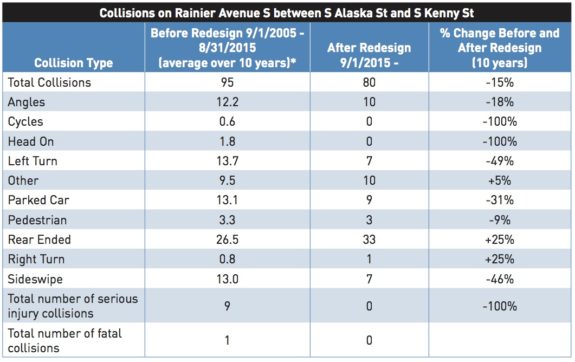
Biking to preschool this morning, as my daughter and I biked across the University Bridge like we do every morning, we saw some Seattle Police boats fishing in the calm waters of Lake Union below us. But they weren’t searching for fish, they were searching for a human being, the victim of a horrific act of violence hundreds of feet above the water.
The exact details are not all clear yet, but several people reported via Twitter that they saw a stalled vehicle on the bridge on the I-5 Ship Canal Bridge before two cars collided. The impact was so powerful that the vehicles rolled over. One person was arrested on suspicion of driving under the influence. But the occupant of the other car was missing. The Harbor Patrol found their body hours later. The impact had apparently thrown them over the side of the towering freeway bridge and down hundreds of feet to the lake below.
Our deepest condolences go to this person’s friends and family.
 I didn’t tell my daughter what the boats were doing in the water this morning, but I knew because I had seen the news reports before we left the home. My feed was full of news about the traffic backup. I-5 was closed southbound, and the traffic backup was going to be big. Here this person experienced unimaginable violence, and the news was mostly about a traffic jam. How can our society be so callous about human tragedy?
I didn’t tell my daughter what the boats were doing in the water this morning, but I knew because I had seen the news reports before we left the home. My feed was full of news about the traffic backup. I-5 was closed southbound, and the traffic backup was going to be big. Here this person experienced unimaginable violence, and the news was mostly about a traffic jam. How can our society be so callous about human tragedy?
This morning’s fatality was exceptionally dramatic, but it is otherwise horribly common. 538 people died in Washington State traffic collisions in 2019. Of those, 327 were drivers or passengers in cars. Why do people who drive accept the level of danger they face every day traveling our highways and city streets? Where is the grassroots organization of car drivers demanding safer roadways? These deaths are preventable. This doesn’t happen everywhere, and there are known solutions that make roadways safer. Why is there no organization of drivers demanding that our public agencies implement solutions that could save lives?

Instead, we get the opposite. When community members try to get our city or state to make safety improvements, they face resistance every single step of the way from an unspoken but dominant force fighting to keep streets dangerous as though dangerous streets are in the best interest of people in cars. The assumption is that people in cars want to sacrifice human lives to save a little travel time. I ask you, car drivers, is this how you feel? If not, then you need to speak up.
Here’s just one example. When the city’s Vision Zero team redesigned a section of Rainier Ave S in 2015, they successfully reduced the most dangerous types of car collisions (head-on and t-bone collisions). This wasn’t magic or good luck, it was the team’s goal. They used well-known traffic safety strategies to achieve this safety improvement. The street averaged nine serious injuries and one death per year before the changes were put in place. In the year after the changes, there were zero serious injuries or deaths. Zero.

And yet the city is currently planning a redesign of the section of Rainier just north of this 2015 project, and they are not including similar safety designs there. This is unacceptable, and people working for safer streets for biking and walking are pushing back. But the city is fighting against safety advocates on behalf of what they assume people driving want: Shorter car travel times at the cost of human life.
Vision Zero is a paradigm shift that challenges people to snap out of the mindset that traffic deaths and injuries are acceptable and inevitable. Instead, it tasks the designers of our transportation system (and the politicians who develop their budgets) to take action and make changes so that the system is safe for people to use. Seattle claims to have a Vision Zero plan and policies in place, but SDOT’s actions demonstrate that we do not.
Our city is lucky to have a lot of people who dedicate their energy to making streets safer for walking and biking. Cascade Bicycle Club, Seattle Neighborhood Greenways, and many smaller neighborhood-level groups do a lot of work to try to improve our streets. Yes, safer streets are easier to cross on foot and bike lanes make it easier to bike. But safer streets are also safer for driving cars. They might be a little slower (though not always), but we are paying far too high a cost to gain a few miles per hour.








Comments
9 responses to “Where are the people demanding safer roadways for driving?”
The popular opinion is that you reduce your risk of dying in a car accident, not by making the streets safer, but my upgrading your armor, so if you do get in a head-on collision with someone, you kill them, rather than them killing you. Upgrading your armor means buying the biggest, heaviest (and most gas-guzzling) SUV you can possibly afford and never venturing anywhere on a bike without tons of steel armor to protect you. The fact that upgrading your own armor makes others more likely to die is ignored, since everyone believes themselves to the the best driver.
The “upgrading armor” paradigm also creates an arms race, causing cars to get bigger and bigger, becoming more and more deadly to pedestrians every year.
I don’t know how we break through to people that, collectively, safer streets is much more effective at preventing deaths than armor upgrades.
I’d be perfectly happy with speed humps every 100 feet
Plenty of people die in SUVs too. Bigger cars don’t mean safer cars, but I get what the commenter is saying about safety vs armor upgrades. Going back to this morning’s terrible tragedy, we now know that one of the cars stalled, and the person driving that car was flung over the bridge when hit from behind by the driver who is now under arrest (possible DUI). Surely speed also played a factor. You’d have to be driving fast and impaired (or distracted) enough to not notice a stalled vehicle in your lane until it’s too late. The ship canal bridge is not a safe place to stall out, and there’s really no safe place of refuge on that bridge. So, yes, us drivers do need to demand safer roadways.
Tom, can you do an article on who is influential in SDOT, who needs to be replaced, and who should replace them ? Let’s fix SDOT.
Excellent question.
The answer is not at SDOT. The answers are embedded in American culture, represented by people we elect who direct our transportation agencies. The “traffic report” Tom listened to did not have to say “car traffic report”, even though car traffic is the only kind of traffic it reports. “Car” is unspoken because it is the norm, and can just be assumed. Changing this is taking a big, slow, culture change, not just a simple agency staffing shake-up.
While we are at it, I am sick and tired of the phrase car accident. Very few of them are accidents. They are mistakes that cost lives. Make mistakes, lose license.
Hear Hear. Make mistake, lose license. Personal responsibility, what a concept!
The person who died was standing outside, next to their car. If you stall, pull over as far as possible & remain seat-belted in your vehicle until help arrives.
When the Netherlands decided to make streets safer in the 1970’s it was not just because of the outrage over pedestrian and bicyclist injuries and fatalities, rather it was about road safety for all. It took them years to get to achieve their current infrastructure but it only took them a short time to inact lowering speed limits because they knew that speed was the main culprit in the majority of deaths. But they started and persisted and we have started and we will persist.